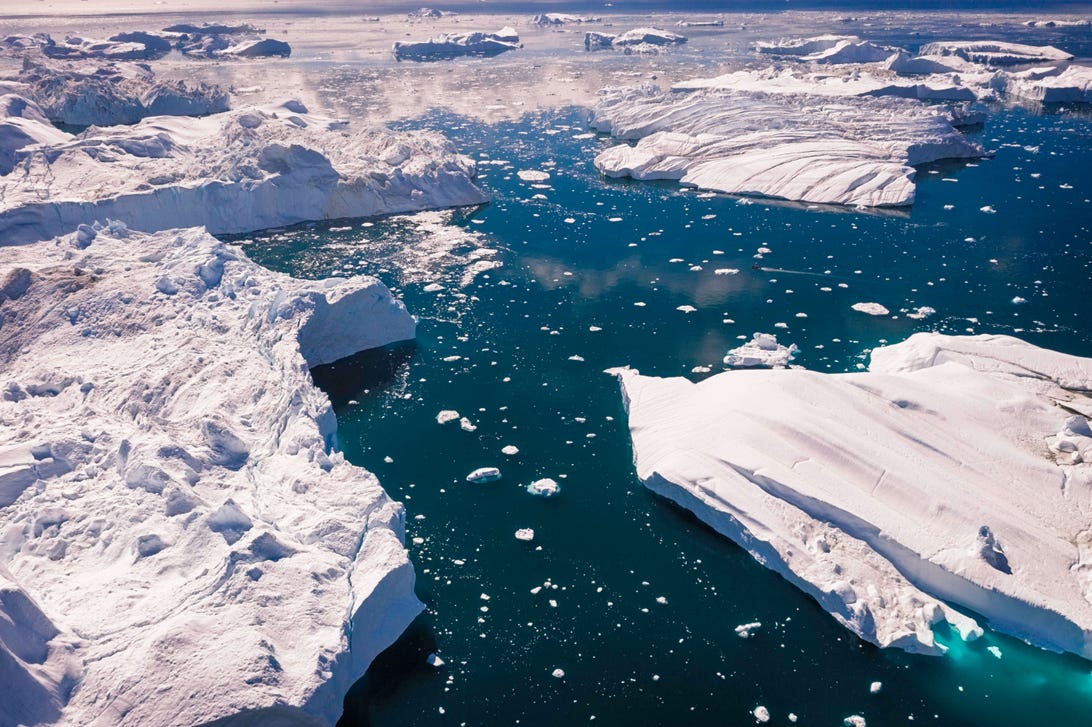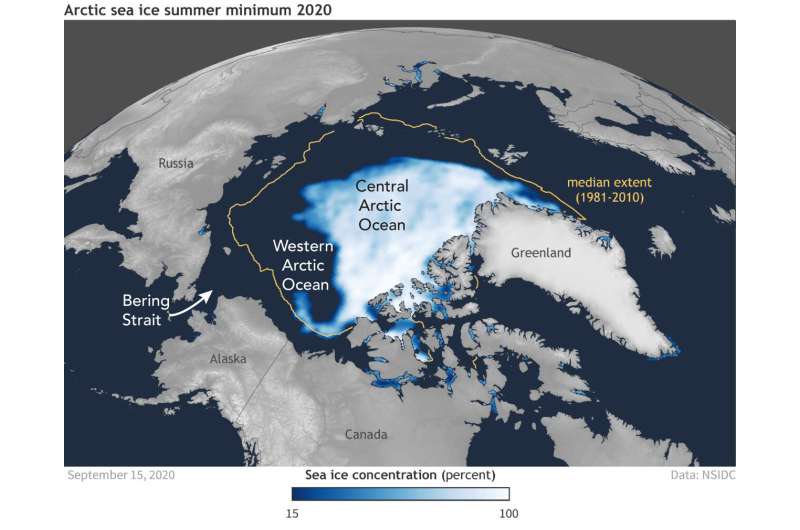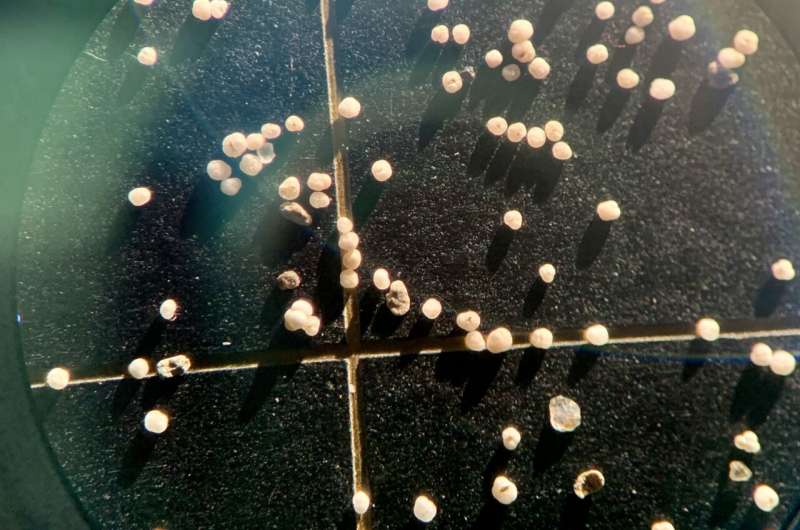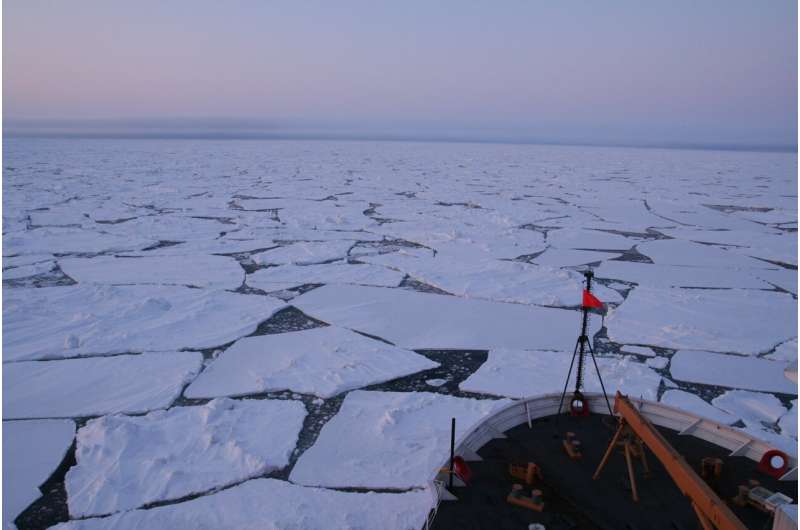Some scientists have predicted shrinking sea ice and more light reaching the Arctic Ocean's surface could mean more plankton. New research suggests otherwise.
Abrar Al-Heeti
Aug. 16, 2021

Shrinking sea ice may not benefit plankton after all.
Climate change is warming the Arctic Ocean and causing sea ice to shrink. Some of these changes will be irreversible but scientists have predicted the lack of sea ice could see more light reach the ocean's surface, unwittingly leading to a boon in plankton. The tiny organisms sit at the bottom of the food web and are critical for fish and other sea life to feed on.
In 2020, huge blooms of one type of plankton were spotted in the open Arctic. Researchers have recorded an increase in plankton productivity and shown climate change is providing a lot more space to expand into as sea ice diminishes. Sounds good? It might not be.
According to a study published in Nature Geoscience on Monday, shrinking sea ice may spell doom for plankton.
A team of scientists led by Princeton University and the Max Planck Institute for Chemistry used fossilized plankton and ice cores to examine the history of sources and supply rates of nitrogen, a vital nutrient for plankton, to the western and central open Arctic Ocean.
Their research suggests with global warming, these waters will have less nitrogen -- negatively affecting plankton productivity.
"Looking at the Arctic Ocean from space, it's difficult to see water at all, as much of the Arctic Ocean is covered by a layer of sea ice," said Jesse Farmer, lead author of the study, geoscientist at Princeton University and visiting postdoctoral fellow at the Max Planck Institute for Chemistry, in a statement. That sea ice naturally expands in the winter and contracts in the summer. In recent decades, global warming has led to a rapid drop in summer sea ice coverage, with that ice cover now being around half of what it was in 1979.
While melting sea ice should mean photosynthesizing plankton making up the base of Arctic food webs could reap the benefits of having more light, there's a catch, according to contributing author Julie Granger, an associate professor of marine sciences at the University of Connecticut.
"These plankton also need nutrients to grow and nutrients are only abundant deeper in the Arctic Ocean, just beyond the reach of the plankton," Granger said. Whether plankton can get those nutrients is a matter of how "stratified" the upper ocean is, or how much it's separated into layers. The upper 600 feet of the ocean is made up of layers of water with varying densities, based on temperature and saltiness.
"When the upper ocean is strongly stratified, with very light water floating on top of dense deep water, the supply of nutrients to the sunlit surface is slow," Farmer said.
New research found the amount of nitrogen in the Arctic has changed since the last ice age, showing the history of stratification in the Arctic Ocean. The Arctic is where the Pacific and Atlantic oceans meet. Fresh Pacific water flows over the saltier water from the Atlantic, which leaves the western Arctic packed with nitrogen flowing in from the Pacific.
It wasn't always like that.
"During the last ice age, when the growth of ice sheets lowered global sea level, the Bering Strait didn't exist," Daniel Sigman, professor of geological and geophysical sciences at Princeton, said in a statement. Back then, the Bering Strait was instead the Bering Land Bridge, which connected Asia and North America and allowed humans to migrate to the Americas.
At the end of the ice age 11,500 years ago, when ice sheets melted and sea levels went up, the Bering Land Bridge was submerged, allowing nitrogen from the Pacific to creep into the open western Arctic basin.
During the last ice age and under colder climate, stratification in the Arctic was weak. After the ice age, central Arctic stratification became stronger, peaking during a time of naturally warmer Arctic summer temperatures some 10,000 and 6,000 years ago, a time known as the Holocene Thermal Maximum. Since then, stratification in the central Arctic has grown weaker, which has allowed the deeper nitrogen to move up towards the surface, where it can be used by plankton.
The climate crisis is seeing warmer temperatures in the Arctic, returning it to a climate similar to the Holocene Thermal Maximum. Although some scientists have suggested increasing amounts of sunlight touching the ocean could make Arctic plankton more productive, scientists from Monday's study found this isn't likely because of nitrogen availability in open regions of the Arctic. Low nitrogen means poor plankton productivity and hurts one of the foundational organisms in the ecosystems food web.
"Given our data, a rise in open Arctic productivity seems unlikely," Farmer said. "The best hope for a future rise in Arctic productivity is probably in the Arctic's coastal waters."
First published on Aug. 16, 2021
The Arctic Ocean's deep past provides clues to its imminent future

As the North Pole, the Arctic Ocean, and the surrounding Arctic land warm rapidly, scientists are racing to understand the warming's effects on Arctic ecosystems. With shrinking sea ice, more light reaches the surface of the Arctic Ocean. Some have predicted that this will lead to more plankton, which in turn would support fish and other animals.
Not so fast, says a team of scientists led by Princeton University and the Max Planck Institute for Chemistry.
They point to nitrogen, a vital nutrient. The researchers used fossilized plankton to study the history of sources and supply rates of nitrogen to the western and central open Arctic Ocean. Their work, detailed in a paper in the current issue of the journal Nature Geoscience, suggests that under a global warming regime, these open Arctic waters will experience more intense nitrogen limitation, likely preventing a rise in productivity.
"Looking at the Arctic Ocean from space, it's difficult to see water at all, as much of the Arctic Ocean is covered by a layer of sea ice," said lead author Jesse Farmer, a postdoctoral research associate in the Department of Geosciences at Princeton University who is also a visiting postdoctoral fellow at the Max Planck Institute for Chemistry in Mainz, Germany. This sea ice naturally expands during winters and contracts during summers. In recent decades, however, global warming has caused a rapid decline in summer sea ice coverage, with summer ice cover now roughly half that of 1979.
As sea ice melts, photosynthesizing plankton that form the base of Arctic food webs should benefit from the greater light availability. "But there's a catch," said contributing author Julie Granger, an associate professor of marine sciences at the University of Connecticut. "These plankton also need nutrients to grow, and nutrients are only abundant deeper in the Arctic Ocean, just beyond the reach of the plankton." Whether plankton can acquire these nutrients depends on how strictly the upper ocean is "stratified," or separated into layers. The upper 200 meters (660 feet) of the ocean consists of distinct layers of water with different densities, determined by their temperature and saltiness.

"When the upper ocean is strongly stratified, with very light water floating on top of dense deep water, the supply of nutrients to the sunlit surface is slow," said Farmer.
New research led by scientists from Princeton University shows how the supply of nitrogen to the Arctic has changed since the last ice age, which reveals the history of Arctic Ocean stratification. Using sediment cores from the western and central Arctic Ocean, the researchers measured the isotopic composition of organic nitrogen trapped in the limestone fossils of foraminifera (plankton that grew in surface waters, then died and sank to the sea floor). Their measurements reveal how the proportions of Atlantic- and Pacific-derived nitrogen changed over time, while also tracking changes in the degree of nitrogen limitation of plankton at the surface. Ona Underwood of the Class of 2021 was a key member of the research team, analyzing western Arctic Ocean sediment cores for her junior project.
Where the oceans meet: Pacific waters float above saltier, denser Atlantic waters
The Arctic Ocean is the meeting place of two great oceans: the Pacific and the Atlantic. In the western Arctic, Pacific Ocean waters flow northward across the shallow Bering Strait that separates Alaska from Siberia. Arriving in the Arctic Ocean, the relatively fresh Pacific water flows over saltier water from the Atlantic. As a result, the upper water column of the western Arctic is dominated by Pacific-sourced nitrogen and is strongly stratified.
However, this was not always the case. "During the last ice age, when the growth of ice sheets lowered global sea level, the Bering Strait didn't exist," said Daniel Sigman, Princeton's Dusenbury Professor of Geological and Geophysical Sciences and one of Farmer's research mentors. At that time, the Bering Strait was replaced by the Bering Land Bridge, a land connection between Asia and North America that allowed for the migration of humans into the Americas. Without the Bering Strait, the Arctic would only have Atlantic water, and the nitrogen data confirm this.

When the ice age ended 11,500 years ago, as ice sheets melted and sea level rose, the data show the sudden appearance of Pacific nitrogen in the open western Arctic basin, dramatic evidence of the opening of the Bering Strait.
"We had expected to see this signal in the data, but not so clearly!" Sigman said.
This was just the first of the surprises. Analyzing the data, Farmer also realized that, prior to the opening of the Bering Strait, the Arctic had not been strongly stratified as it is today. Only with opening the Bering Strait did the western Arctic become strongly stratified, as reflected by the onset of nitrogen limitation of plankton in the surface waters.
Heading eastward away from the Bering Strait, the Pacific-sourced water is diluted away, so that the modern central and eastern Arctic are dominated by Atlantic water and relatively weak stratification. Here, the researchers found that nitrogen limitation and density stratification varied with climate. As in the western Arctic, stratification was weak during the last ice age, when climate was colder. After the ice age, central Arctic stratification strengthened, reaching a peak between about 10,000 and 6,000 years ago, a period of naturally warmer Arctic summer temperatures called the "Holocene Thermal Maximum." Since that time, central Arctic stratification has weakened, allowing enough deep nitrogen to reach surface waters to exceed the requirements of plankton.
Global warming is quickly returning the Arctic to the climate of the Holocene Thermal Maximum. As this warming continues, some scientists have predicted that reduced ice cover would enhance the productivity of Arctic plankton by increasing the amount of sunlight reaching the ocean. The new historical information acquired by Farmer and his colleagues suggests that such a change is unlikely for the open basin waters of the western and central Arctic. The western Arctic will remain strongly stratified due to persistent inflow of Pacific water through the Bering Strait, while the warming will strengthen stratification in the central Arctic. In both of these open ocean regions, slow nitrogen supply is likely to limit plankton productivity, the researchers concluded.
"A rise in the productivity of the open Arctic basin would likely have been seen as a benefit, for example, increasing fisheries," said Farmer. "But given our data, a rise in open Arctic productivity seems unlikely. The best hope for a future rise in Arctic productivity is probably in the Arctic's coastal waters."
Rivers melt Arctic ice, warming air and ocean
More information: Arctic Ocean stratification set by sea level and freshwater inputs since the last ice age, Nature Geoscience (2021). DOI: 10.1038/s41561-021-00789-y , www.nature.com/articles/s41561-021-00789-y
Shiv Priyam Raghuraman et al, Anthropogenic forcing and response yield observed positive trend in Earth's energy imbalance, Nature Communications (2021). DOI: 10.1038/s41467-021-24544-4
Journal information: Nature Communications , Nature Geoscience
Provided by Princeton University
No comments:
Post a Comment